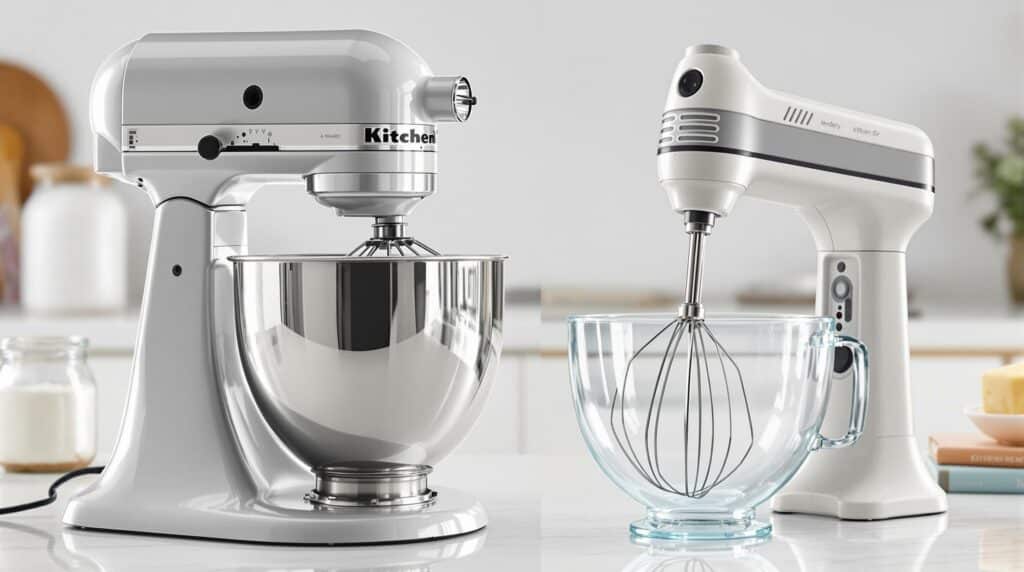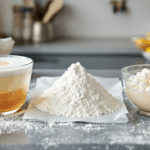Step into the world of baking, and you’ll quickly encounter the electric mixer – that whirring kitchen appliance promising smoother batters, loftier peaks, and easier dough handling. But then comes the question: which kind? Do you need the iconic, countertop-dominating stand mixer, often seen as the ultimate baker’s prize? Or is the nimble, budget-friendly electric hand mixer sufficient for your needs? This “mixer mania” can be confusing for aspiring bakers trying to equip their kitchens smartly.
Is a stand mixer an essential investment from day one? Can a simple hand mixer truly handle everything a recipe throws at it, including kneading dough? Weighing the pros, cons, capabilities, and costs of each type is crucial before making a purchase. This guide will delve into the stand mixer versus hand mixer debate, comparing their strengths, weaknesses, best uses, and key differences to help you decide which electrical mixing partner, if any, deserves a place in your baking toolkit right now. While one might seem mightier, the true “supreme” ruler might just depend on the kingdom you plan to bake in.
Meet the Contenders: Hand Mixer vs. Stand Mixer
Let’s start with a clear picture of our two main electrical mixing contenders:
- Electric Hand Mixer: This is a compact, lightweight, handheld motorized unit. It comes with removable attachments – typically two traditional beaters, and sometimes whisks or dough hooks. The baker holds the mixer and manually moves it around within a separate mixing bowl of their choosing. Power levels vary, but are generally lower than stand mixers.
- Stand Mixer: This is a larger, heavier, stationary appliance designed to sit on the countertop. It features a powerful motor housed in an overhead “head,” a sturdy base that locks the mixer (and often the bowl) in place, and a dedicated mixing bowl specifically designed for the machine. It uses interchangeable attachments – commonly a flat paddle (or flat beater), a wire whip (whisk), and a dough hook – which typically operate with planetary action: the attachment spins on its own axis while simultaneously orbiting around the bowl, ensuring thorough mixing without constantly needing to rotate the bowl itself. The key benefit here is powerful, hands-free operation.
The Hand Mixer: Pros & Cons
The accessible and familiar hand mixer has plenty to offer, especially for beginners.
Advantages (Pros):
- Affordability: This is a major plus. Hand mixers are significantly cheaper than stand mixers, often costing a fraction of the price. They provide electrical mixing power without a hefty investment.
- Compact & Portable: Their small size makes them incredibly easy to store in a drawer or cupboard, ideal for kitchens with limited space. They require no dedicated counter real estate and are easy to pull out when needed and put away afterwards.
- Versatility (Bowl Choice): You’re not tied to a specific bowl size or type. You can use a hand mixer with virtually any mixing bowl you already own, large or small.
- Great for Lighter Tasks: They excel at many common baking tasks: efficiently whipping cream or egg whites to fluffy peaks, mixing cake batters and quick breads, making frostings and glazes, creaming butter and sugar for average-sized batches of cookies, and even tasks like mashing potatoes.
- Control & Maneuverability: Being handheld gives you direct control over where the beaters are in the bowl. You can easily target specific areas, tilt the bowl, and adjust the mixing angle as needed.
Disadvantages (Cons):
- Requires Manual Effort: You must actively hold and guide the mixer during the entire mixing process. This can become tiring for tasks requiring extended mixing times, like whipping egg whites for a long time or creaming butter and sugar thoroughly.
- Less Powerful Motor: Compared to stand mixers, hand mixers have significantly less powerful motors. They often struggle with thicker, heavier doughs like large batches of stiff cookie dough or, most notably, bread dough.
- Ineffective Dough Hooks: While many models come with dough hook attachments, the motors generally lack the torque and power needed to properly knead and develop gluten in anything but the smallest, softest doughs. Attempting heavy kneading risks burning out the motor.
- Less Stability: Since you’re holding it, there’s a greater chance of splashing ingredients out of the bowl if you’re not careful, especially when starting up or at higher speeds. The bowl itself might also shift around on the counter.
- Hands Aren’t Free: Because you need one hand to hold the mixer (and often another to stabilize the bowl), it’s difficult to gradually add ingredients while the mixer is running at speed. You typically need to stop mixing to add things.
- Can Be Slower: For tasks like whipping egg whites to stiff peaks or thoroughly creaming butter and sugar, a hand mixer might take noticeably longer than a powerful stand mixer.
The Stand Mixer: Pros & Cons
The coveted stand mixer is a powerhouse, but comes with its own set of considerations.
Advantages (Pros):
- Superior Power & Efficiency: This is their biggest selling point. Stand mixers boast robust motors designed to handle tough jobs with ease. They can power through large batches of stiff cookie dough and, crucially, effectively knead bread dough using the dough hook attachment, developing gluten efficiently.
- Hands-Free Operation: Once you add ingredients and turn it on, the mixer does the work. This frees up your hands to measure and add subsequent ingredients, prepare the next step, or simply tidy up. It makes multi-stage recipes much easier to manage.
- Stability: Their heavy weight and sturdy construction mean they stay put on the counter, even when tackling heavy doughs at higher speeds. The bowl locks securely into the base.
- Thorough Mixing (Planetary Action): The planetary mixing action (where the beater spins while orbiting the bowl) ensures that ingredients from the center to the sides of the bowl are incorporated thoroughly and evenly, generally requiring less manual scraping than with a hand mixer (though occasional scraping is still recommended).
- Larger Capacity: Stand mixer bowls are typically larger than average mixing bowls (common sizes are 4.5 to 7 quarts), allowing you to comfortably make bigger batches of batter or dough.
- Attachment Versatility: Beyond the standard paddle, whisk, and dough hook, many brands (especially KitchenAid) offer a wide array of optional attachments that utilize the mixer’s motor hub for tasks like grinding meat, making pasta, rolling dough sheets, churning ice cream, spiralizing vegetables, or juicing citrus. This can turn it into a multi-purpose kitchen appliance.
Disadvantages (Cons):
- Significant Cost: Stand mixers represent a substantial financial investment, often costing anywhere from $200 to $600 or more, depending on the brand, model, and power.
- Size & Weight: They are large, heavy appliances that demand a significant amount of dedicated countertop space or hefty storage room in a cupboard. They are not easily moved around.
- Bowl Limitation: You are generally restricted to using the specific mixing bowl(s) designed to fit that model of stand mixer. While extra bowls can often be purchased, you can’t just grab any bowl from your cupboard.
- Potential for Over-Mixing/Over-Kneading: The power and hands-free nature make it easier to walk away and accidentally overmix a delicate cake batter (leading to toughness) or over-knead bread dough (damaging the gluten structure). Vigilance is required.
- Cleaning: While the removable bowl and attachments are usually dishwasher-safe, they are bulky. The mixer unit itself needs careful wiping down and can have nooks and crannies where flour can accumulate.
Head-to-Head: Key Considerations for Choosing
So, how do you decide which mixer, if any, is right for you? Consider these factors:
- Your Primary Baking Habits: What do you bake most often, or what do you aspire to bake regularly?
- Frequent Bread, Pizza Dough, Large Batches of Cookies: The power and kneading capability of a stand mixer offer a significant advantage and will save you considerable time and effort.
- Occasional Cakes, Muffins, Cookies (standard batches), Frostings, Whipped Cream: A good quality hand mixer is likely perfectly adequate for these tasks.
- Your Budget: Hand mixers are significantly more affordable and accessible. Stand mixers are a long-term investment. Be realistic about what you can comfortably spend.
- Your Kitchen Space: Do you have ample counter space to dedicate to a large appliance, or is storage space limited? Hand mixers win easily on compactness.
- Typical Batch Size: Are you usually baking just for yourself or a small household, or do you frequently make large quantities for family gatherings, bake sales, or events? Stand mixers handle volume much better.
- Physical Considerations: If holding a hand mixer for extended periods would be difficult or uncomfortable due to wrist, hand, or arm issues, the hands-free operation of a stand mixer could be a major benefit.
- Future Baking Goals: Are you just starting out and testing the waters, or do you envision baking becoming a serious, long-term hobby where investing in a powerful tool makes sense?
Can a Hand Mixer Really Knead Dough?
This question deserves a direct answer. While many hand mixers include small, corkscrew-like dough hook attachments, they are generally not effective for kneading most bread doughs. Here’s why:
- Insufficient Power: The motors in hand mixers lack the necessary torque (rotational force) to manipulate and develop the gluten in a stiff or even moderately stiff bread dough properly.
- Risk of Motor Burnout: Forcing a hand mixer to work through heavy dough puts immense strain on its motor, significantly increasing the risk of overheating and permanent damage.
- Inefficient Action: The small hooks and lack of planetary action mean they don’t knead the dough as effectively or evenly as a stand mixer’s C-shaped or spiral dough hook.
For occasional, very small batches of extremely soft, enriched dough, a hand mixer might manage some initial mixing, but for standard bread recipes requiring proper gluten development, you’ll need to rely on hand kneading or a stand mixer. Don’t buy a hand mixer primarily for its dough hooks; you’ll likely be disappointed.
The Verdict: Which Reigns Supreme?
After weighing the pros and cons, it becomes clear that there’s no single “supreme” mixer for everyone. The best choice is highly personal and depends entirely on the individual baker’s circumstances and needs.
- The Electric Hand Mixer is the undisputed champion of affordability, storage, and versatility for lighter tasks. It’s an excellent starting point for beginners and perfectly capable for a wide range of common baking projects like cakes, muffins, cookies, and whipping.
- The Stand Mixer reigns supreme in terms of power, efficiency for heavy tasks (especially kneading), hands-free convenience, and large-batch capacity. It’s a worthwhile investment for frequent, dedicated bakers, particularly those serious about bread making or regularly tackling large recipes.
And let’s not forget the third option: no electric mixer at all! For centuries, all baking was done by hand using whisks, spoons, and sheer muscle power. While mixers offer undeniable convenience and efficiency for certain tasks, you can absolutely produce wonderful baked goods without one, especially when starting out.
Conclusion: Choose Your Mixing Partner Wisely
Both hand mixers and stand mixers are valuable tools in a baker’s arsenal, each excelling in different areas. The hand mixer offers accessibility and competence for everyday tasks, while the stand mixer provides power and convenience for more demanding jobs and larger volumes.
Before succumbing to “mixer mania” and buying the biggest, shiniest machine, realistically assess your baking habits, budget, and kitchen space. Don’t feel pressured into buying a stand mixer if your baking mainly involves occasional cakes and cookies – a good hand mixer might serve you perfectly well for years. Conversely, if you dream of mastering sourdough or baking multiple loaves each week, investing in a stand mixer could be a game-changer. Remember that you can always start with the basics (or a hand mixer) and upgrade later if your passion and needs grow. The truly “supreme” mixer is the one that empowers your specific baking journey right now.







